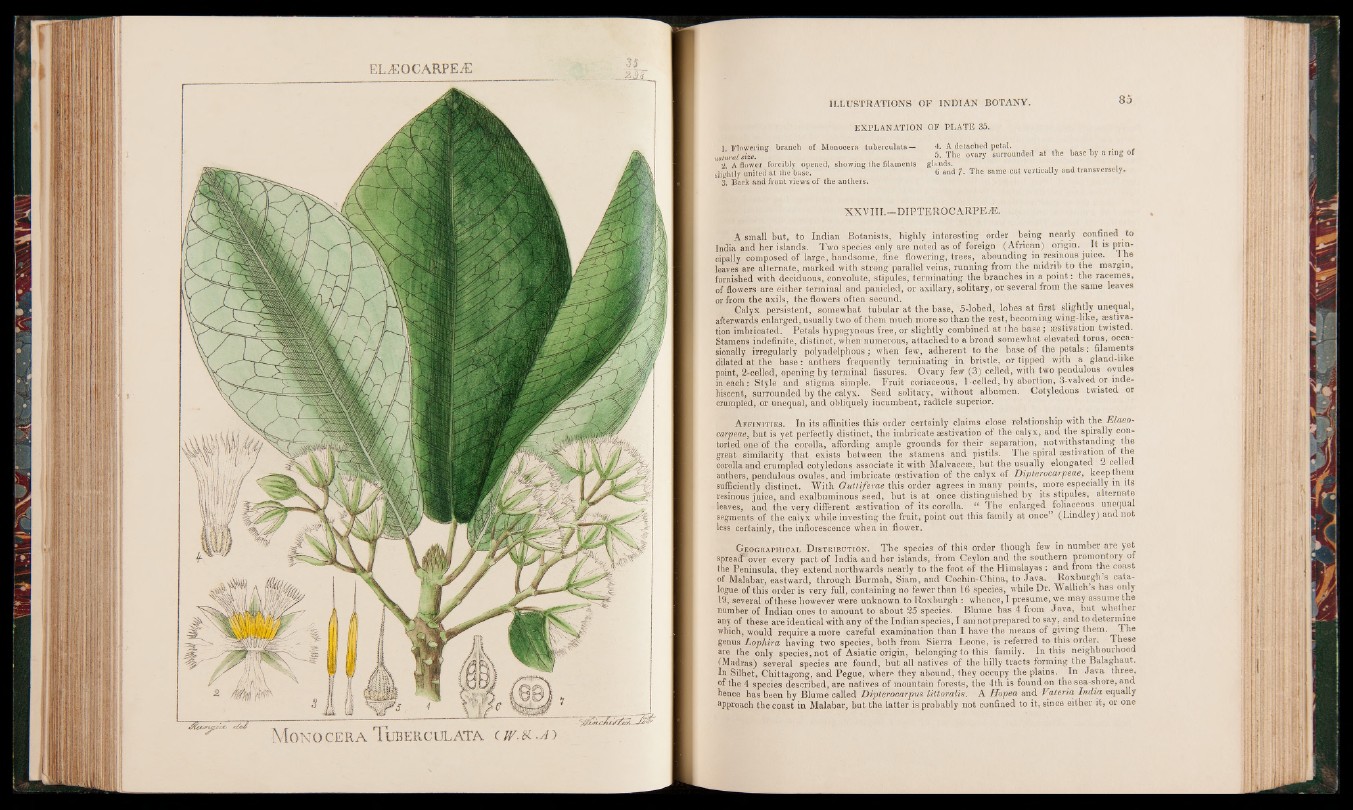
ELÆOCARPEÆ
Mono cera Tuberculata ‘d r& M)
EXPLANATION OF PLATE 35.
4. A detached petal.
5. The ovary surrounded at the base by a ring of
glands. - -- '■ -•
6 and 7. The same cut vertically and transversely.
1. Flowering branch of Monocera tuberculata—
natural size.
'2. A flower forcibly opened, showing the filaments
slightly united at the base.
3. Back and front views of the anthers.
XXVIII.^DIPTEROCARPEÆ.
A small but, to Indian Botanists, highly interesting order being nearly confined to
India and her islands. Two species only are noted as of foreign (African) origin. It is principally
composed of large, handsome, fine flowering, trees, a b o u n d in g in resinous juice. J he
leaves are alternate, marked with strong parallel veins, running from the midrib to the margin,
furnished with deciduous, convolute, stipules, terminating the branches in a point: the racemes,
of flowers are either terminal and panicled, or axillary, solitary, or several from the same leaves
or: from the axils, the flowers often secund, .
Calyx persistent, somewhat tubular at the base, 5-lobed, lobes at first slightly unequal,
afterwards enlarged, usually two of them much more so than the rest, becoming wing-like, aestivation
imbricated. Petals hypogynous free, or slightly combined at the base; aestivation twisted.
Stamens indefinite, distinct, when'numerous, attached to a broad somewhat elevated torus, occasionally
irregularly polyadelphous; when few, adherent to the base of the petals : filaments
dilated at the base: anthers frequently terminating in bristle, or tipped with a gland-like
point, 2-celled, opening by terminal fissures. Ovary few (3) celled, with two pendulous ovules
in each: Style and stigma simple. Fruit coriaceous, 1 -Celled, by abortion, 3-valved or mde-
hiscent, surrounded by the calyx. Seed solitary, without albumen. Cotyledons twisted or
crumpled, or unequal, and obliquely incumbent, radicle superior.
A f f in it ie s . In its affinities this order certainly claims close relationship with t-he Elaeo*
carpeae, but is yet perfectly distinct, the imbricate aestivation of the calyx, and the spirally con-
torted one of the corolla, affording ample grounds for their separation, notwithstanding the
great similarity that exists between the stamens and pistils. The spiral aestivation of the
corolla and crumpled cotyledons associate it with Malvaceae, but the usually elongated 2 celled
anthers, pendulous ovules, and imbricate aestivation of the calyx of Dipterocarpeae, keep them
sufficiently distinct. With Guttiferae this order agrees in many points, more especially in its
resinous juice, and exalbuminous seed, but is at once distinguished by its stipules, alternate
leaves, and the very different aestivation of its corolla. “ The enlarged ^ foliaceous unequal
segments of the calyx while investing the fruit, point out this family at once” (Lindley) and not
less certainly, the inflorescence when in flower.
G eographical D istr ibu t io n . The species of this order though few in number are yet
spread^over every part of India and her islands, from Ceylon and the southern promontory of
the Peninsula, they extend northwards nearly to the foot of the Himalayas : and from the coast
of Malabar, eastward, through Burmah, Siam, and Cochin-China, to Java. Roxburgh s catalogue
of this order is very full, containing no fewer than 16 species, while Dr. Wallich s has only
19, several of these however were unknown to Roxburgh : whence, I presume, we may assume the
number of Indian ones to amount to about 25 species. Blume has 4 from Java, but whether
any of these are identical with any of the Indian species, I am not prepared to say, and to determine
which, would require a more careful examination than I have the means of giving them. The
genus Lophira having two species, both from Sierra Leone, is referred to this order. Thes®
are the only species, not of Asiatic origin, belonging to this family. In this neighbourhood
(Madras) several species are found, but all natives of the hilly tracts forming the Balaghaut.
In Silhet, Chittagong, and Pegue, wher« they abound, they occupy the plains. In Java three,
of the 4 species described, are natives of mountain forests, the 4th is found on the sea-shore, and
hence has been by Blume called Dipterocarpus littoralis. A Hoped and Vateria India equally
approach the coast in Malabar, but the latter is probably not confined to it, since either it, or one